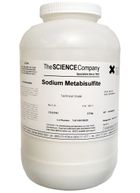Sodium metabisulphite: Difference between revisions
Jump to navigation
Jump to search
Uncle Jesse (talk | contribs) (Initial page creation) |
Uncle Jesse (talk | contribs) (Adding image) |
||
| Line 1: | Line 1: | ||
[[File:Sodium_metabisulphite.jpg|thumb|140px|right|Sodium metabisulphite]] | |||
Sodium Metabisulfite: One of two compounds commonly used to sanitize winemaking equipment and utensiles, the other being potassium metabisulfite. Its action, in water, inhibits harmful bacteria through the release of [[sulfur dioxide]] (SO<sub>2</sub>), a powerful antiseptic. It can be used for sanitizing equipment, but the U.S. government prohibits its inclusion in commercial [[wine]] and thus should not be used to sanitize the [[must]] from which wine is to be made. It is about 17.5% stronger than potassium metabisulfite and should be mixed accordingly. | Sodium Metabisulfite: One of two compounds commonly used to sanitize winemaking equipment and utensiles, the other being potassium metabisulfite. Its action, in water, inhibits harmful bacteria through the release of [[sulfur dioxide]] (SO<sub>2</sub>), a powerful antiseptic. It can be used for sanitizing equipment, but the U.S. government prohibits its inclusion in commercial [[wine]] and thus should not be used to sanitize the [[must]] from which wine is to be made. It is about 17.5% stronger than potassium metabisulfite and should be mixed accordingly. | ||
[[Category:Glossary]] | [[Category:Glossary]] | ||
Latest revision as of 21:55, 19 September 2017
Sodium Metabisulfite: One of two compounds commonly used to sanitize winemaking equipment and utensiles, the other being potassium metabisulfite. Its action, in water, inhibits harmful bacteria through the release of sulfur dioxide (SO2), a powerful antiseptic. It can be used for sanitizing equipment, but the U.S. government prohibits its inclusion in commercial wine and thus should not be used to sanitize the must from which wine is to be made. It is about 17.5% stronger than potassium metabisulfite and should be mixed accordingly.
